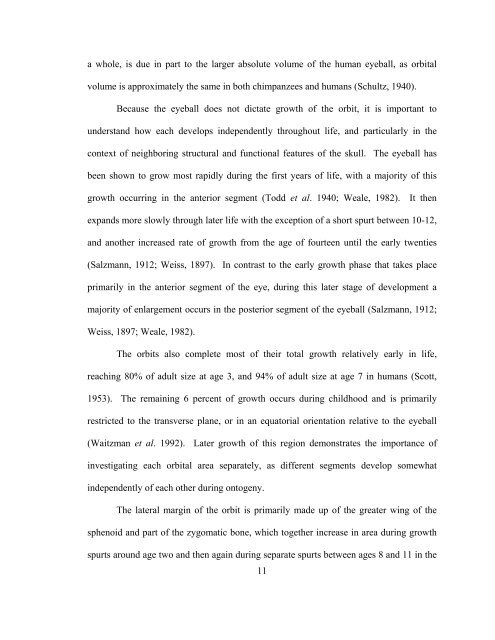modern variation and evolutionary change in the hominin eye orbit
modern variation and evolutionary change in the hominin eye orbit
modern variation and evolutionary change in the hominin eye orbit
You also want an ePaper? Increase the reach of your titles
YUMPU automatically turns print PDFs into web optimized ePapers that Google loves.
a whole, is due <strong>in</strong> part to <strong>the</strong> larger absolute volume of <strong>the</strong> human <strong>eye</strong>ball, as <strong>orbit</strong>alvolume is approximately <strong>the</strong> same <strong>in</strong> both chimpanzees <strong>and</strong> humans (Schultz, 1940).Because <strong>the</strong> <strong>eye</strong>ball does not dictate growth of <strong>the</strong> <strong>orbit</strong>, it is important tounderst<strong>and</strong> how each develops <strong>in</strong>dependently throughout life, <strong>and</strong> particularly <strong>in</strong> <strong>the</strong>context of neighbor<strong>in</strong>g structural <strong>and</strong> functional features of <strong>the</strong> skull. The <strong>eye</strong>ball hasbeen shown to grow most rapidly dur<strong>in</strong>g <strong>the</strong> first years of life, with a majority of thisgrowth occurr<strong>in</strong>g <strong>in</strong> <strong>the</strong> anterior segment (Todd et al. 1940; Weale, 1982). It <strong>the</strong>nexp<strong>and</strong>s more slowly through later life with <strong>the</strong> exception of a short spurt between 10-12,<strong>and</strong> ano<strong>the</strong>r <strong>in</strong>creased rate of growth from <strong>the</strong> age of fourteen until <strong>the</strong> early twenties(Salzmann, 1912; Weiss, 1897). In contrast to <strong>the</strong> early growth phase that takes placeprimarily <strong>in</strong> <strong>the</strong> anterior segment of <strong>the</strong> <strong>eye</strong>, dur<strong>in</strong>g this later stage of development amajority of enlargement occurs <strong>in</strong> <strong>the</strong> posterior segment of <strong>the</strong> <strong>eye</strong>ball (Salzmann, 1912;Weiss, 1897; Weale, 1982).The <strong>orbit</strong>s also complete most of <strong>the</strong>ir total growth relatively early <strong>in</strong> life,reach<strong>in</strong>g 80% of adult size at age 3, <strong>and</strong> 94% of adult size at age 7 <strong>in</strong> humans (Scott,1953). The rema<strong>in</strong><strong>in</strong>g 6 percent of growth occurs dur<strong>in</strong>g childhood <strong>and</strong> is primarilyrestricted to <strong>the</strong> transverse plane, or <strong>in</strong> an equatorial orientation relative to <strong>the</strong> <strong>eye</strong>ball(Waitzman et al. 1992). Later growth of this region demonstrates <strong>the</strong> importance of<strong>in</strong>vestigat<strong>in</strong>g each <strong>orbit</strong>al area separately, as different segments develop somewhat<strong>in</strong>dependently of each o<strong>the</strong>r dur<strong>in</strong>g ontogeny.The lateral marg<strong>in</strong> of <strong>the</strong> <strong>orbit</strong> is primarily made up of <strong>the</strong> greater w<strong>in</strong>g of <strong>the</strong>sphenoid <strong>and</strong> part of <strong>the</strong> zygomatic bone, which toge<strong>the</strong>r <strong>in</strong>crease <strong>in</strong> area dur<strong>in</strong>g growthspurts around age two <strong>and</strong> <strong>the</strong>n aga<strong>in</strong> dur<strong>in</strong>g separate spurts between ages 8 <strong>and</strong> 11 <strong>in</strong> <strong>the</strong>11
















